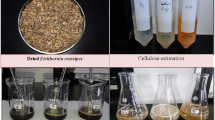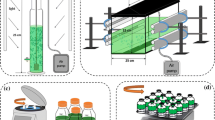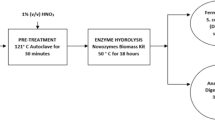Abstract
Marine biomass is washed ashore on beaches used for recreational purposes causing problems for local and spa authorities. The present management of marine waste biomass does not include a sustainable disposing policy and biomass is dumped inadequately. Since macroalgae are receiving increasing attention in the field of biofuel production, this “spare” biomass may present a potential feedstock in biogas plants. The present study shows an increase in methane production from macroalgae Fucus vesiculosus collected from the beach by applying thermo-acidic pretreatment to enhance hydrolysis of polymeric molecules in biomass. Flue gas condensate (FGC), an industrial acidic waste product accumulating in power plants, was used for acid hydrolysis as well as technical HCl and water. Biomethane potential tests were carried out on pretreated samples. Pretreatment conditions of 80 °C using 0.2 M HCl and a reaction time of 24 h resulted in a +140 % increase of methane yield in biogas production. FGC and hot-water pretreatment at 80 °C for 24 h yielded +38 and +51 % more methane than untreated biomass, respectively. Lower temperature pretreatment (20 and 50 °C) did not show considerable improvement of methane yield neither in water nor in acidic media except when using 0.2 M HCl at 50 °C (+83 %). An extended pretreatment reaction time of 24 h did not reveal any additional recovery of methane compared to a reaction time of 2 h. The full pretreatment effect is already deployed below 2 h. To attain maximum efficiency in the pretreatment process, the amendatory combination of both heat and acidity is necessary.


Similar content being viewed by others
References
Adams JMM, Toop TA, Donnison IS, Gallagher JA (2011) Seasonal variation in Laminaria digitata and its impact on biochemical conversion routes to biofuels. Bioresour Technol 102:9976–9984
Allen E, Browne J, Hynes S, Murphy JD (2013) The potential of algae blooms to produce renewable gaseous fuel. Waste Manag 33:2425–2433
Barsanti L, Gualtieri P (2006) Algae—anatomy, biochemistry and biotechnology. CRC Press, Boca Raton, pp 278–280
Bioprocess Control Sweden AB (2013) AMPTS II—automatic methane potential test system, operation and maintenance manual. http://www.bioprocesscontrol.com/media/45898/Manual-AMPTS-II-version-1.6.pdf. Accessed 7 Apr 2014
Bird KT, Chynoweth DP, Jerger DE (1990) Effects of marine algal proximate composition on methane yields. J Appl Phycol 2:207–213
Börjesson P, Mattiasson B (2008) Biogas as a resource-efficient vehicle fuel. Trends Biotechnol 26:7–13
Buswell AM, Boruff BS (1932) The relation between the chemical composition of organic matter and the quality and quantity of gas produced during sludge digestion. Sewage Works J 4:454–460
Carlsson AS, van Beilen J, Möller R, Clayton D (2007) Micro- and macro-algae: utility for industrial applications. EPOBIO. CPL Press, New York, 82 pp
Charlier RH, Morand P, Finkl CW, Thys A (2007) Green tides on the Brittany Coasts. Environ Res 3:52–59
Demirbas A, Demirbas MF (2010) Algae energy: algae as a new source of biodiesel. Springer, London, 280 pp
Demirel B, Scherer P (2011) Trace element requirements of agricultural biogas digesters during biological conversion of renewable biomass to methane. Biomass Bioenergy 35:992–998
Deublein D, Steinhauser A (2008) Biogas from waste and renewable resources - an introduction. Weinheim, Wiley-VCH, 450 pp
Draget KI, Smidsrød O, Skjåk-Bræk G (2005) Alginates from algae. In: Steinbüchel A, Rhee SK (eds) Polysaccharides and polyamides in the food industry. Properties, Production and Patents. Wiley-VCH, Weinheim
Falk H (2011) Monitoring the anaerobic digestion process. PhD Thesis, Jacobs University Bremen, Germany, pp 52-63
FAO (2010) The state of world fisheries and aquaculture. Food and Agriculture Organization of the United Nations, Rome, pp 3–4
Feijiu W (1988) Seminar report on the status of seaweed culture in China, India, Indonesia. Food and Agriculture Organization of the United Nations, Rome. NACA-SF/WP/88/5
Frigon J, Guiot SR (2010) Biomethane production from starch and lignocellulosic crops: a comparative review. Biofuel Bioprod Bioref 4:447–458
Gao K, McKinley K (1994) Use of macroalgae for marine biomass production and CO2 remediation: a review. J Appl Phycol 6:45–60
González-Fernández C, Sialve B, Bernet N, Steyer JP (2012) Thermal pretreatment to improve methane production of Scenedesmus biomass. Biomass Bioenergy 40:105–111
Habig C, Ryther JH (1983) Methane production from the anaerobic digestion of some marine macrophytes. Resour Conserv 8:271–279
Horn SJ (2000) Bioenergy from brown seaweeds. PhD Thesis, Norwegian University of Science and Technology (NTNU), Norway, 83 pp
Horn SJ (2009) Seaweed biofuels: production of biogas and bioethanol from brown macroalgae. VDM Verlag, Saarbrücken, 104 pp
Hughes AD, Maeve SK, Black KD, Stanley MS (2012) Biogas from macroalgae: is it time to revisit the idea? Biotechnol Biofuels 5:86
Jang S, Shirai Y, Uchida M, Wakisaka M (2012) Production of mono sugar from acid hydrolysis of seaweed. Afr J Biotechnol 11:1953–1963
Jung K, Kim D, Kim H, Shin H (2011a) Optimization of combined (acid + thermal) pretreatment for fermentative hydrogen production from Laminaria japonica using response surface methodology (RSM). Int J Hydrog Energy 36:9626–9631
Jung K, Kim D, Shin H (2011b) Fermentative hydrogen production from Laminaria japonica and optimization of thermal pretreatment conditions. Bioresour Technol 102:2745–2750
Jung KA, Lim S, Kim Y, Park JM (2013) Potentials of macroalgae as feedstocks for biorefinery. Bioresour Technol 135:182–190
Kaiser F, Metzner T, Effenberger M, Gronauer A (2008) Sicherung der Prozessstabilität in landwirtschaftlichen Biogasanlagen. Bayrische Landesanstalt für Landwirtschaft (LfL), Freising-Weihenstephan, pp 14
Kelly MS, Dworjanyn S (2008) The potential of marine biomass for anaerobic biogas production—a feasibility study with recommendations for further research. The Crown Estate—Marine Estate Research Report 2008, Oban, Scotland, pp 1–100
Kraan S (2013) Mass-cultivation of carbohydrate rich macroalgae, a possible solution for sustainable biofuel production. Mitig Adapt Strateg Glob Chang 18:27–46
Lee JY, Kim YS, Um BH, Oh K (2013) Pretreatment of Laminaria japonica for bioethanol production with extremely low acid concentration. Renew Energy 54:196–200
Liu J, Olsson G, Mattiasson B (2004) Control of an anaerobic reactor towards maximum biogas production. Water Sci Technol 50:189–198
Lohmann C, Schilling P (2001) 1. Taxonomischer Makrophyten—Workshop “Taxonomie mariner Makrophyten und ihre Bedeutung für das Monitoring im Rahmen der internationalen Meeresschutzabkommen”. Umweltbundesamt, Berlin, p 136
Long T, Meng G, Wu L, Zhang X, Guo W (2011) Numerical simulation for effects of hydrodynamic condition on algae growth in Chongqing reaches of Jialing River. Ecol Model 222:112–119
Matsui T, Koike Y (2010) Methane fermentation of a mixture of seaweed and milk at a pilot-scale plant. J Biosci Bioeng 110:558–563
McHugh DJ (2003) A guide to the seaweed industry. FAO Fisheries, Rome. Technical paper 441 pp 1–105
Mossbauer M, Haller I, Dahlke S, Schernewski G (2012) Management of stranded eelgrass and macroalgae along the German Baltic coastline. Ocean Coast Manag 57:1–9
Murphy JD, Thamsiriroj T (2012) Fundamental science and engineering of the anaerobic digestion process. In: Wellinger A, Murphy J, Baxter D (eds) The biogas handbook: science, production and applications. Woodhead Publishing, Cambridge, p 512
Nelson TA, Lee DJ, Smith BC (2003) Are “Green Tides” Harmful Algal Blooms? Toxic properties of macroalgae, Ulva fenestrata and Ulvaria obscura (Ulvophyceae). J Phycol 39:874–879
Pereira L (2011) A review of the nutrient composition of selected edible seaweeds. In: Pomin VH (ed) Seaweed: ecology, nutrient composition and medicinal uses. Nova Science Publishers Inc, Hauppauge, pp 15–47
Rigoni-Stern S, Rismondo R, Szpyrkowicz L, Zilio-Grandi F, Vigato PA (1990) Anaerobic digestion of nitrophilic algal biomass from the Venice lagoon. Biomass 23:179–199
Rupérez P, Ahrazem O, Leal JA (2002) Potential antioxidant capacity of sulfated polysaccharides from the edible marine brown seaweed Fucus vesiculosus. J Agric Food Chem 50:840–845
Samson R, Leduy A (1982) Biogas production from anaerobic digestion of Spirulina maxima algal biomass. Biotechnol Bioeng 24:1919–1924
Schattauer A, Abdoun E, Weiland P, Plöchl M, Heiermann M (2011) Abundance of trace elements in demonstration biogas plants. Biosyst Eng 108:57–65
Schmitz PM, Kavallari A (2009) Crop plants versus energy plants—on the international food crisis. Bioorg Med Chem 17:4020–4021
Smyth BM, Gallachóir BPÓ, Korres NE, Murphy JD (2010) Can we meet targets for biofuels and renewable energy in transport given the constraints imposed by policy in agriculture and energy? J Clean Prod 18:1671–1685
Sprenger F (2011) Kondenswasser aus Heizkesseln und dessen Neutralisation. Buderus Heiztechnik GmbH, Wetzlar, Germany. http://www.sbz-monteur.de/wp-content/uploads/2011/07/kondenswasser.pdf. Accessed 23 Apr 2014
Thomsen L (2010) How ‘green’ are algae farms for biofuel production? Biofuels 1:515–517
Thomsen C, Rill S, Thomsen L (2012) Case study with temperature controlled outdoor PBR system in Bremen. In: Posten C, Walter C (eds) Microalgal biotechnology: integration and economy. Walter de Gruyter, Berlin, pp 74–77
Valiela I, McClelland J, Hauxwell J, Behr PJ, Hersh D, Foreman K (1997) Macroalgal blooms in shallow estuaries: controls and ecophysiological and ecosystem consequences. Limnol Oceanogr 42:1105–1118
VDI 4630 (2006) Fermentation of organic materials—characterisation of the substrate, sampling, collection of material data, fermentation tests. Beuth Verlag GmbH, Berlin, p 92
Vivekanand V, Eijsink VH, Horn SJ (2012) Biogas production from the brown seaweed Saccharina latissima: thermal pretreatment and codigestion with wheat straw. J Appl Phycol 24:1295–1301
Vodegel S, Kristin A, Thomsen C (2011) Strandalgen als Energierohstoff—Eine Verwertungsmöglichkeit? Müll und Abfall 7:319–321
Walker M, Zhang Y, Heaven S, Banks C (2009) Potential errors in the quantitative evaluation of biogas production in anaerobic digestion processes. Bioresour Technol 100:6339–6346
Wei N, Quarterman J, Jin Y (2013) Marine macroalgae: an untapped resource for producing fuels and chemicals. Trends Biotechnol 31:70–77
Zhang J, Huo Y, Yu K, Chen Q, He Q, Han W, Chen L, Cao J, Shi D, He P (2013) Growth characteristics and reproductive capability of green tide algae in Rudong coast, China. J Appl Phycol 25:795–803
Acknowledgments
This work was supported by the European Union and funded by the Europäischer Fond für regionale Entwicklung (EFRE, Projektnummer FV211A).
Cordial thanks to our partner OceanLab of Jacobs University Bremen and Phytolutions GmbH for helpful discussions and information, the provision of flue gas condensate and the algae biomass.
Author information
Authors and Affiliations
Corresponding author
Rights and permissions
About this article
Cite this article
Barbot, Y.N., Falk, H.M. & Benz, R. Thermo-acidic pretreatment of marine brown algae Fucus vesiculosus to increase methane production—a disposal principle for macroalgae waste from beaches. J Appl Phycol 27, 601–609 (2015). https://doi.org/10.1007/s10811-014-0339-x
Received:
Revised:
Accepted:
Published:
Issue Date:
DOI: https://doi.org/10.1007/s10811-014-0339-x




